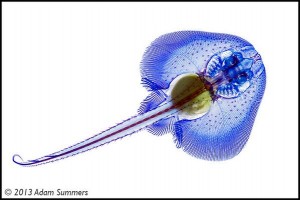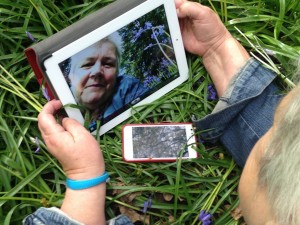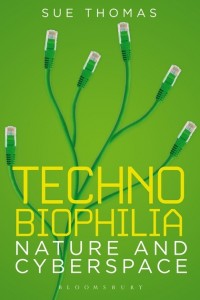GrrlScientist has written a fascinating ;piece about skates (fish), poetry, and Twitter for her Dec. 5, 2013 posting on the Guardian Science Blog network (Note: A link has been removed),
Twitter is a wonderful medium. For example, a couple days ago, I met University of Washington Biology Professor Adam Summers on twitter. It turns out that he is Associate Director of Friday Harbor Labs, where I spent a summer taking an intensive molecular neurobiology course during my graduate training in zoology. …
…
“Skates are fabulous animals”, Professor Summers writes in email.
“They make up a quarter of the diversity of cartilaginous fishes and every darn one of the 250 species looks pretty much exactly like every other one.”
Thus, studies into the anatomy and development of one species may provide insight into these processes for other, rarer, species.
“The little skate, also called the hedgehog skate, was one of my go-to organisms for many years”, writes Professor Summers in email.
These studies provide the basis for a physical or a mathematical model that may help understand function. This model is of course tested both against its inspiration and as a predictive tool. For example, the skate’s tail is very important, even for the developing embryo.
“I figured out that it can’t survive on the oxygen that diffuses through the capsule. Instead it has to pump water through by vibrating its tail.”
Perhaps this is the reason that the tail muscles differ from what’s considered normal.
“A wonderful muscle physiologist showed that the muscle in the tail is cardiac muscle rather than the striated muscle it should be”, Professor Summers writes.
While colleagues thought Summers’ specimens were good enough to be compared to visual art, his little skate specimens also inspired a poet (from the posting),
“I got chatting with a friend who teaches a poetry class up here [at Friday Harbor]. Sierra Nelson and I had several long conversations about the similarity of the lens that poets and scientists bring to the world.”
“I think the poem does a much better job of engaging the viewer than my dry prose on the critter.”
Little Skate
Leucoraja erinaceaLittlest of little skates, just barely hatched!
You can still see the remnants
of my yellow egg sac.And my tail’s a little longer
than my whole body
(I’ll grow into it more eventually).….
Adam Summers shared one of his images of his ‘stained’ little skate specimens on his twitter feed (pic.twitter.com/UWCKeVMmYB)
I recommend reading GrrlScientist’s posting (Inside a mermaid’s purse; A poetic intersection between life and science, art and photography) for the whole story and, for that matter, the whole poem. As for the mermaid purse, this is the name for the little skate’s egg sack when found on the beach.
This all reminded me of Aileen Penner, a writer, poet, and science communications specialist located in Vancouver, Canada and her work in science and creative writing. She wrote a Nov. 19, 2013 posting about the intersection of nature and writing titled: US Forest Service Scientist Says Writers Help Gather “Cultural Data” on our Relationship With the Natural World (Note: Links have been removed),
Who is Fred Swanson you ask? Yes he is a retired U.S. Forest Service scientist and yes he is a Forest Ecology Professor at Oregon State University (OSU), but he is also a key figure in the Spring Creek Project for Ideas, Nature, and the Written Word. This is a program I have been following since 2006 and greatly admire for their commitment to bring together “the practical wisdom of the environmental sciences, the clarity of philosophical analysis, and the creative, expressive power of the written word, to find new ways to understand and re-imagine our relation to the natural world.”
In April of 2012, I went to OSU to interview the Director of the Spring Creek Project, Charles Goodrich. I wanted to know how to fund such a long-term interdisciplinary project. Charles talked a lot about Fred Swanson and his enthusiasm for having writers as part of the inquiry process and about Swanson’s personal commitment to writing the arts into scientific funding proposals for his work at the H.J. Andrew Experimental Forest.
Penner was inspired by an Andrew C. Gottleib article (About Earth Scientist Fred Swanson) in Terrain’s Fall 2013 issue and quotes from it throughout her own posting. She also notes this (Note: Links have been removed),
Terrain interviewer Andrew Gottlieb will moderate a panel “Artists in the Old-Growth” with Alison Hawthorne Deming, Fred Swanson, Charles Goodrich and Spring Creek Project Founder, Kathleen Dean Moore at the upcoming AWP conference in Seattle on February 27, 2014. If you are in Seattle for this – go see it!
Before investigating the Association of Writers and Writing Programs (AWP) 2014 conference and the special session any further, here’s a bit more information about the Spring Creek Project for Ideas, Nature, and the Written Word, from the homepage,
Spring Creek Project engages the most daunting and urgent environmental issues of our times while remembering and sharing our perennial sources of joy, wonder, and gratitude. We are a convening organization that sponsors writers’ residencies, readings, lectures, conversations, and symposia on issues and themes of critical importance to the health of humans and nature. We believe sharing insights, inspiration, and methods from many perspectives increases our understanding of the place of humans in nature. Our goal is to include participants and audience members from every discipline and persuasion, from creative writing and the other arts, from the environmental and social sciences, from philosophy and other humanistic disciplines.
The AWP conference seems mainly focused on fiction and literary nonfiction (at least, that’s what the video highlights [on the 2014 conference homepage] of the 2013 conference would suggest). Here’s more from the 2014 AWP conference homepage,
Each year, AWP holds its Annual Conference & Bookfair in a different city to celebrate the authors, teachers, students, writing programs, literary centers, and publishers of that region. More than 12,000 writers and readers attended our 2013 conference, and over 650 exhibitors were represented at our bookfair. AWP’s is now the largest literary conference in North America. We hope you’ll join us in 2014.
2014 AWP Conference & BookfairWashington State Convention Center &
Sheraton Seattle Hotel
February 26 – March 1, 2014
Key Dates:November 8, 2013: deadline for purchasing a conference program ad
November 15, 2013: offsite event schedule opens
January 22, 2014: preregistration rates end
January 23, 2014: will-call registration begins
February 26, 2014: onsite registration begins
Here are some details about the R231 Artists in the Old-Growth: OSU’s Spring Creek Project & the HJ Andrews Experimental Forest
AWP 2014 conference session,
Room 602/603, Washington State Convention Center, Level 6
Thursday, February 27, 2014
3:00 pm to 4:15 pm
How can a residency program empower and generate inquiry and creative responses to our astonishing world? How can a long-term, place-based program affect the way we see our relation to the forest? The world? Join this discussion with the founders and participants of the Oregon State University-based Spring Creek Project that brings writers to a place of old-growth forest and ground-breaking forest science.Andrew Gottlieb Moderator
Andrew C. Gottlieb is the Book Reviews Editor for Terrain.org, and his writing has appeared in journals like Ecotone, ISLE, Poets & Writers, and Salon.com. He’s the author of a chapbook of poems, Halflives, and he won the 2010 American Fiction Prize.
Fred SwansonFred Swanson co-directs the Long-Term Ecological Reflections program based at the H.J. Andrews Experimental Forest in the Oregon Cascade Range, which has hosted more than forty writers in residence and a variety of humanities-science interactions. He is a retired US Forest Service scientist.
Kathleen Dean MooreKathleen Dean Moore is an essayist and environmental ethicist, author of Riverwalking, Holdfast, Pine Island Paradox, and Wild Comfort, and co-editor of the climate ethics book, Moral Ground. She is co-founder and now Senior Fellow of the Spring Creek Project at Oregon State University.
Alison DemingAlison Hawthorne Deming is author of four poetry books, most recently Rope, and three nonfiction books with Zoologies: On Animals and the Human Spirit forthcoming. She is Director and Professor of Creative Writing at the University of Arizona.
Charles GoodrichCharles Goodrich is the author of three books of poetry, A Scripture of Crows; Going to Seed: Dispatches from the Garden; and Insects of South Corvallis; and a collection of essays, The Practice of Home. He serves as Director for the Spring Creek Project for Ideas, Nature, and the Written Word
One last note about nature and writing, I interviewed Sue Thomas, author of Technobiophilia: nature and cyberspace, in a Sept. 20,,2013 posting about her book and other projects.


